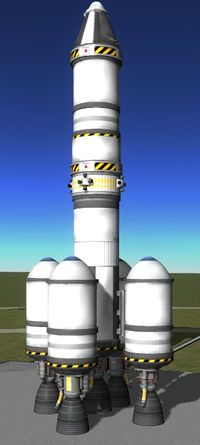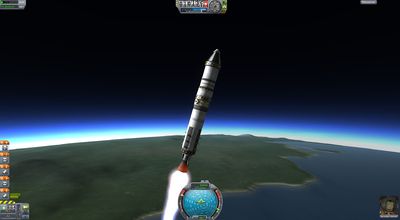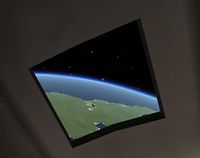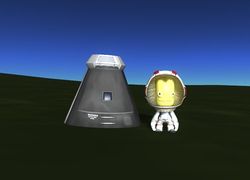Difference between revisions of "Tutorial: Vostok 1/zh-cn"
(zh-cn index chapter) |
(→Ship Design) |
||
| Line 7: | Line 7: | ||
1961 年 4 月 12 日,苏联宇航员尤里·加加林乘坐“东方” 1 号飞船发射升空,并绕地球飞行。加加林是第一位亲眼从太空中观察地球的人,并亲身体验了长时间的失重。继“斯普特尼克”之后,苏联人又一次让美国的太空计划蒙羞,他们完成了首次载人航天飞行。这最终导致了约翰·F·肯尼迪总统的那次著名演讲,他表示将举全国之力在十年之内完成登月,因为他不希望看到苏联再次拔得头筹。 | 1961 年 4 月 12 日,苏联宇航员尤里·加加林乘坐“东方” 1 号飞船发射升空,并绕地球飞行。加加林是第一位亲眼从太空中观察地球的人,并亲身体验了长时间的失重。继“斯普特尼克”之后,苏联人又一次让美国的太空计划蒙羞,他们完成了首次载人航天飞行。这最终导致了约翰·F·肯尼迪总统的那次著名演讲,他表示将举全国之力在十年之内完成登月,因为他不希望看到苏联再次拔得头筹。 | ||
| − | == | + | == 载人飞船及火箭设计 == |
| − | + | 具有讽刺意味的是,KSP 中设计载人飞船甚至要比无人飞船还要容易一点,因为乘员舱具有自维持能力。也就是说,我们不用再像“斯普特尼克”任务时必须考虑为其提供能源。取而代之的是,我们要安装另一个组件来保证我们的加加林能安全返回:降落伞。 | |
| − | + | 不过这次的任务载荷加大了一些。而且我们还需要额外的燃料去完成飞船的脱离轨道和返回地面的操作。我们解决问题的思路和苏联人当初的做法差不多,在“斯普特尼克”的运载火箭上再加入一个第三级。 | |
[[File:Vostok-ground.jpg|200px|right]] | [[File:Vostok-ground.jpg|200px|right]] | ||
| − | * | + | * 任务负载段 |
| − | ** 1x [[Mk16 Parachute]] | + | ** 1x [[Mk16 Parachute|Mk16 型降落伞]] |
| − | ** 1x [[Command Pod Mk1]] | + | ** 1x [[Command Pod Mk1|Mk1 型指令舱]] |
| − | * | + | * 第三级 |
| − | ** 1x [[TR-18A Stack Decoupler]] | + | ** 1x [[TR-18A Stack Decoupler|TR18A 型级间分离环]] |
| − | ** 1x [[FL-T400 Fuel Tank]] | + | ** 1x [[FL-T400 Fuel Tank|FL-T400 型燃料舱]] |
| − | ** 1x [[LV-909 Liquid Fuel Engine]] | + | ** 1x [[LV-909 Liquid Fuel Engine|LV-909 型液体燃料火箭发动机]] |
| − | * | + | * 第二级 |
| − | ** 1x [[TR-18A Stack Decoupler]] | + | ** 1x [[TR-18A Stack Decoupler|TR18A 型级间分离环]] |
| − | ** 1x [[FL-R25 RCS Fuel Tank]] | + | ** 1x [[FL-R25 RCS Fuel Tank|FL-R25 型 RCS 燃料舱]] |
| − | ** 4x [[RV-105 RCS Thruster Block]] | + | ** 4x [[RV-105 RCS Thruster Block|RV-105 型 RCS 模块]] |
| − | ** 1x [[FL-T800 Fuel Tank]] | + | ** 1x [[FL-T800 Fuel Tank|FL-T800 型燃料舱]] |
| − | ** 1x [[LV-T30 Liquid Fuel Engine]] | + | ** 1x [[LV-T30 Liquid Fuel Engine|LV-T30 型液体燃料火箭发动机]] |
| − | * | + | * 第一级 |
| − | ** 4x [[TT-38K Radial Decoupler]] | + | ** 4x [[TT-38K Radial Decoupler|TT-38K 型径向分离机构]] |
| − | ** 4x [[FL-T400 Fuel Tank]] | + | ** 4x [[FL-T400 Fuel Tank|FL-T400 型燃料舱]] |
| − | ** 4x [[Aerodynamic Nose Cone]] | + | ** 4x [[Aerodynamic Nose Cone|流线型鼻锥]] |
| − | ** 4x [[LV-T30 Liquid Fuel Engine]] | + | ** 4x [[LV-T30 Liquid Fuel Engine|LV-T30 型液体燃料火箭发动机]] |
| − | + | 要注意的是,单组元推进剂 RCS 发动机及其燃料依然处于第二级。这意味着它们无法在火箭末段飞行起作用。不过这不是问题,因为飞船本身有操控设备,其能力完全可以满足最上级的飞控任务。 | |
| − | + | 另外,最末级并没有使用 LV-T30 型发动机,而是更轻、更节约燃料的 LV-909型发动机。只有离开大气层后,该级发动机才会点火启动,而在这个阶段,发动机的经济性远比推力重要的多。 | |
== Mission Phases == | == Mission Phases == | ||
Revision as of 05:55, 31 May 2013
| “ | 在环绕地球的飞船上,我看到了我们的行星家园是如此的美丽。人类啊,请努力保留并升华这份美丽吧,千万不要毁灭它! — 尤里·加加林 |
” |
在发射无人卫星并把它送入轨道之后,我们现在将进入太空探险的下一个篇章:把 Kerbal 小绿人送入太空并安全返回。
1961 年 4 月 12 日,苏联宇航员尤里·加加林乘坐“东方” 1 号飞船发射升空,并绕地球飞行。加加林是第一位亲眼从太空中观察地球的人,并亲身体验了长时间的失重。继“斯普特尼克”之后,苏联人又一次让美国的太空计划蒙羞,他们完成了首次载人航天飞行。这最终导致了约翰·F·肯尼迪总统的那次著名演讲,他表示将举全国之力在十年之内完成登月,因为他不希望看到苏联再次拔得头筹。
载人飞船及火箭设计
具有讽刺意味的是,KSP 中设计载人飞船甚至要比无人飞船还要容易一点,因为乘员舱具有自维持能力。也就是说,我们不用再像“斯普特尼克”任务时必须考虑为其提供能源。取而代之的是,我们要安装另一个组件来保证我们的加加林能安全返回:降落伞。
不过这次的任务载荷加大了一些。而且我们还需要额外的燃料去完成飞船的脱离轨道和返回地面的操作。我们解决问题的思路和苏联人当初的做法差不多,在“斯普特尼克”的运载火箭上再加入一个第三级。
- 任务负载段
- 第三级
- 1x TR18A 型级间分离环
- 1x FL-T400 型燃料舱
- 1x LV-909 型液体燃料火箭发动机
- 第二级
- 1x TR18A 型级间分离环
- 1x FL-R25 型 RCS 燃料舱
- 4x RV-105 型 RCS 模块
- 1x FL-T800 型燃料舱
- 1x LV-T30 型液体燃料火箭发动机
- 第一级
- 4x TT-38K 型径向分离机构
- 4x FL-T400 型燃料舱
- 4x 流线型鼻锥
- 4x LV-T30 型液体燃料火箭发动机
要注意的是,单组元推进剂 RCS 发动机及其燃料依然处于第二级。这意味着它们无法在火箭末段飞行起作用。不过这不是问题,因为飞船本身有操控设备,其能力完全可以满足最上级的飞控任务。
另外,最末级并没有使用 LV-T30 型发动机,而是更轻、更节约燃料的 LV-909型发动机。只有离开大气层后,该级发动机才会点火启动,而在这个阶段,发动机的经济性远比推力重要的多。
Mission Phases
Launch
The launch goes just like that of Sputnik. Launch upwards, dump the first stage, ignite the second and do a gravity-turn after 10km. This rocket requires a much slower gravity-turn than the previous one due to the lower thrust-to-weight ratio of the 2nd stage. So turn the rocket very slowly to the direction marker. In this mission we completely burn the second stage to raise our apoapsis.
Before we reach the apoapsis (the LV-909 engine accelerates slower, so we should start accelerating before we reach it), we use the last stage to enter a circular orbit. Watch out that you don't burn all your fuel, because you still need some left to get back into the atmosphere.
Orbiting
To experience the flight from the perspective of Yuri, click on his portrait and select "IVA" (Intra-Vehicular Activity). This allows you to look out of the small window above him and take a look at Kerbin no Kerbal has ever taken before. Should you see only stars, rotate your craft accordingly (you can do so from the IVA perspective). Should you see only black, you likely are on the night side. Accelerate time until sunrise.
Re-Entry
After Yuri had his fun in orbit, it's time to bring him back home so he can shake hands with politicians, get his parade, write books and go to talk shows. To do so, wait until you are at the apoapsis of your orbit and accelerate retrograde until the trajectory points onto Kerbin's surface. Keep in mind that it doesn't take atmospheric drag into account, so your actual landing will be not as far as the trajectory indicates. Keep this in mind when you intend to land on ground.
When you enter the atmosphere, you will notice a dangerous-looking orange glow around the capsule due to atmospheric reentry heat. But don't worry: as of writing (0.19) this effect is purely visual and can not actually damage your vehicles (with the exception of extended solar panels). In later versions you will likely have to avoid going down too steep, or you will burn up in the atmosphere.
Landing
The real Gagarin didn't actually land with the Vostok 1 - he ejected in the lower atmosphere and landed with a personal parachute. Unfortunately KSP doesn't have personal parachutes (as of 0.19.1.54), so we are going to land with the capsule.
Before you activate your parachute, separate the thruster stage - the MK16 parachute can't carry much more weight than the command capsule. Then deploy the parachute.
There isn't really anything you can do wrong here. When you are in the atmosphere, just activate the parachute like you activate a stage (space), panic for a moment while it doesn't seem to be doing anything, and breath in relief when it opens automatically at exactly 500m above ground.
When the capsule has touched the ground, you can let Yuri exit the capsule by clicking on his portrait and then clicking on "EVA" (Extra-Vehicular Activity). Now you can walk around the landing area and pose in front of the capsule for some press photos.
What now
Now you can go to the next level and learn advanced orbital maneuvers: Extra-vehicular activities and docking.





